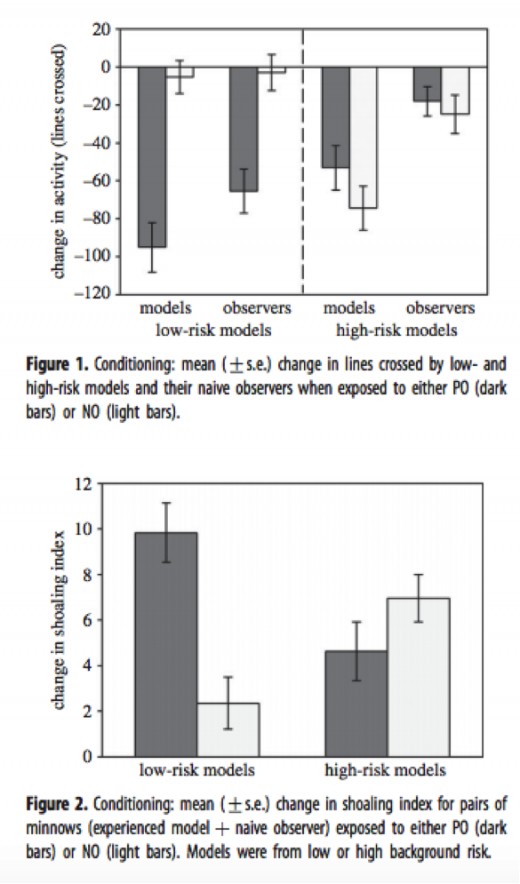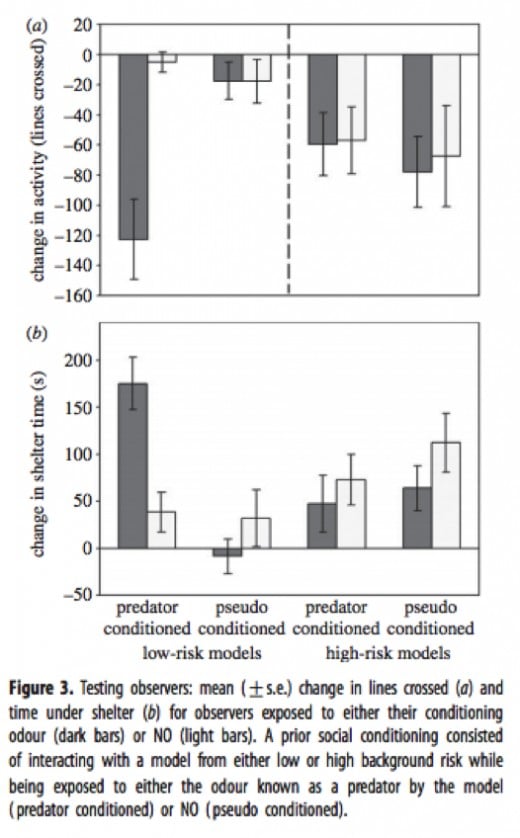Discussion on "Social Learning in a High Risk Environment"
Does level of perceived background threat affect one’s ability to learn? Crane, Mathiron, and Ferrari 2015 think that it can, so they set out to examine the way that fathead minnows (Pimephales promelas) learn from each other in regards to predator responses in different environments. It is already known that minnows respond with antipredator behaviors when exposed to intraspecial alarm cues that are released when another fish is injured (Brown 2003). In minnows, antipredator behavior includes a decrease in movement and an increase in shoaling, or grouping together with other fish, which are the two main things Crane et al. 2015 measured in their study to determine if the minnows learned to associate a certain stimulus with predation. Crane et al. 2015 hypothesized that the antipredator behavior of models living in high-risk environments increases less than that of models in low-risk environments, so observers of high-risk fish may have a harder time learning the to respond to the stimulus. They also hypothesized that observers might be able to distinguish model responses to predator odor and novel odor and tailor their responses accordingly (Crane et al. 2015).
Crane et al. 2015’s experiment consisted of two groups of fish predator-naive flathead minnows: models and observers. The mentor group was further split into two groups: high background risk and low background risk. They were conditioned to the high background risk type by being exposed to alarm cues three times a day for four days, while fish were conditioned to the low risk background type by being exposed to water at the same intervals as a control. Then, on the fourth day of conditioning, all model fish tanks were injected with alarm cues and predator odor (randomly selected both pike and sturgeon odors). This caused the models to associate that predator odor with an alarm cue, indicating to them that the predator odor correlates to a threat. Part two of the experiment involved pairing experienced models with naïve observers, and measuring both movement and shoaling behavior before and after either a predator odor or a novel odor is injected into the water. Part three of the experiment then tests the observers’ responses to either a predator odor or a novel odor and measures movement and time spent hiding.

The results of the study show that high background risk fish experienced neophobia, a fear of unknown stimuli such as the novel odor, while low background risk fish did not, as seen in Figures 1 and 2, showing change in movement and shoaling, respectively (Crane et al. 2015). Additionally, low-risk fish exhibited a greater change in antipredator behavior than high-risk fish when exposed to the predator odor (Crane et al. 2015). Contrary to their hypothesis, Crane et al. 2015 found that observers of high-risk fish did not appear able to differentiate when the model was responding to a predator odor or a novel odor, exhibited in Figure 3. This indicates that neophobia is culturally transmitted rather than a product of social learning (Crane et al. 2015).
While comprehensive, this experiment does have some limitations. One limitation that is acknowledged by Crane et al. 2015 is that although the observed behavioral responses to predator odors and novel odors in the high-risk fish appear to be similar, the responses may actually appear different to other minnows in way either undetectable or yet unmeasured by researchers. If this was true, then one of Crane et al. 2015’s hypotheses that they thought was not supported would actually be supported; observer fish would be able to distinguish between the model’s responses to predator odors and novel odors. While there is no reason to assume that the study is wrong, I would argue that further research into possible methods of communication between fish is warranted, especially since fish are commonly used as model organisms and any extra insight into their behavior could be beneficial in many aspects.

Another limitation is that the predator and novel odors were both from predator fish. I am curious how they minnows would react if the novel odor was from a predator bird, gasoline, a non-predator fish, or even a human. While the fact that low-risk fish did not exhibit much response to the novel odor supports that there is nothing inherently threatening about the novel odor (be it the sturgeon or the pike), I still think it would be interesting to see if the results were replicated with other novel odors. This could lead to many interesting questions. Could you condition the minnows to exhibit antipredator behavior in response to the odor of their own species? Would the minnow become antisocial (the opposite of antipredator shoaling behavior), or even go crazy at its own odor?
Crane et al. 2015 claims that their study could help scientists better understand post-traumatic stress disorder and “secondary traumatization”, a little understood phenomenon where people who spend time with those who have PTSD indirectly acquire symptoms including distress (Arzi, Solomon, and Dekel 2000). Parallels can be drawn between the hyper-vigilant behaviors observed in the high background risk minnows and people who are in high-risk situations. It does not seem like too far of a stretch to think that naïve observers sharing an environment with a high-risk model can pick up on the model’s social cues and either grow habituated to them and learn to ignore them, or grow nervous themselves. Since Crane et al. 2015 just measures the overall change in the behaviors after the stimulus is provided, it is hard to tell whether the observers ignored the high-risk fish and were very calm the entire time, or if they assimilated the nervous behavior and exhibited antipredator behavior both before and after the stimulus. I would argue that this information would be even more useful and relevant to the study of PTSD and secondary traumatization, and could even help predict how humans will act. For example, maybe more timid fish see the vigilant model and increase their own vigilance, becoming more nervous and timid, while braver fish see the vigilant model’s behavior and become habituated to it. This could be tested for in a study with a similar set up to Crane et al. 2015, but with an added part that tests the boldness of the observer before introducing it to the model, and then afterwards tests the antipredator behavior as a whole and ranks it rather than just comparing the behavior before and after the stimulus. The boldness test could be modeled off of an experiment done by Adriaenssens and Johnsson 2013, in which they administer an open field test, a novel-object test, and a mirror test to measure the boldness of a fish. The results of such a study could help predict, and ultimately help people prepare for, how someone may respond to PTSD or secondary traumatization.
Another area in psychology that could benefit from this study and future studies building on the knowledge gained from Crane et al. 2015 would be the bettering of behavioral conditioning therapy, which uses conditioning to encourage beneficial behaviors and discourage maladaptive behaviors (Eysenck and Rachman 7). This type of conditioning therapy can be used for all sorts of disorders, from eating disorders to phobias (Kircher et al. 2013). While psychological disorders most likely have genetic components, a lot of human behavior is learned, like the antipredator behavior of the models and the observers (Eysenck and Rachman 3). Of course, the ability of behaviors to be conditioned is well known and documented in many different species, but the more we can learn about it, the more we can find different ways and nuances to improve conditioning therapy.
Furthermore, Crane et al. 2015 provides some insight into social learning, which could be applied in studying human social learning. In particular, the knowledge gained could be relevant in how humans react to events based on the perceived reactions of others. For example, studies could examine how humans respond in disaster situations, such as natural disasters or terrorist attacks. It seems fairly obvious that when observers see someone panic, they also may panic themselves. However, I wonder if human responses would mirror the results of Crane et al 2015. For example, would bystanders and observers learn less about how to react from “tougher” models or models who have experienced hardships or risky lives? Would observers learn more from those who naturally have a calm demeanor even before a disaster strikes? Results could lead to choosing better leaders and people in positions of authority who are responsible for directing people in emergencies or disasters. This could even have implications in selecting people for police and firefighter positions, since part of their job is leading people out of emergencies safely.
Building on the idea of social learning, the results could also have implications in social media and news media. Especially recently, it seems that inflammatory headlines and “click bait” are frequently found on news channels, social media outlets, and reporting sites. This has been exacerbated by the ease at which technology allows us to see disasters happening all over the globe. It would be interesting to explore if parallels could be drawn between behaviors of people who watch, read, and listen to inflammatory news and the behaviors of high background risk fish, and those of people who do not frequently spend time listening to the news and the low background risk fish. I wonder if people who do not frequently listen to or read the news are less frightened by what would be the equivalent of “novel odors” than those who do frequently watch or read the news. Furthermore, it would be interesting to see the effects of their children, who could be likened to the “observer” fish in Crane et al. 2015’s experiment. I hypothesize that children of frequent news watchers, especially channels or sites with inflammatory content, may have a harder time learning about and distinguishing real threats than the children of people who do not frequently watch or read inflammatory news. While a study examining this may be difficult, particularly because it would involve self-reporting, which can be unreliable, and because it may involve some sketchy ethics when testing the children on how threatening they find certain things, I think it could be useful and educational in the long run.
Overall, it is encouraging to see research being done in the field of animal behavior concerning learning, as this research may become applicable in bettering human lives. Different animals have varied capacities for intelligence and learning, but it seems that the more research is done, the more we discover about just how much animals can learn from their environment, animals of other species, and their conspecifics, and about how similar we all are.
References
Adriaenssens, Bart, and Jorgen I. Johnsson. "Natural Selection, Plasticity and the Emergence of a Behavioral Syndrome in the Wild." Ecology Letters 16 (2013): 47-55. Web.
Arzi, N. Ben, Z. Solomon, and R. Dekel. "Secondary Traumatization among Wives of PTSD and Post-concussion Casualties: Distress, Caregiver Burden and Psychological Separation." Brain Injury 14.8 (2000): 725-36. Web.
Brown, Grant E. "Learning about Danger: Chemical Alarm Cues and Local Risk Assessment in Prey Fishes." Fish and Fisheries 4.3 (2003): 227-34. Web.
Crane, Adam L., Anthony G. E. Mathiron, and Maud C. O. Ferrari. "Social Learning in a High-risk Environment: Incomplete Disregard for the 'minnow That Cried Pike' Results in Culturally Transmitted Neophobia." Proceedings B 282.1812 (2015): n. pag. Royal Society Publishing. Web.
Eysenck, H. J., and S. Rachman. The Causes and Cures of Neurosis (Psychology Revivals): An Introduction to Modern Behaviour Therapy Based on Learning Theory and the Principles of Conditioning. New York: Routledge, 2013. Print.
Kircher, Tilo, Volker Arolt, Andreas Jansen, Martin Pyka, Isabelle Reinhardt, Thilo Kellermann, Carsten Konrad, Ulrike Lueken, Andrew T. Gloster, Alexander L. Gerlach, Andreas Strohle, Andre Wittmann, Bettina Pfleiderer, Hans-Ulrich Wittchen, and Benjamin Straube. "Effect of Cognitive-Behavioral Therapy on Neural Correlates of Fear Conditioning in Panic Disorder." Biological Psychiatry 73.1 (2013): 93-101. Web.
© 2016 ReverieMarie









